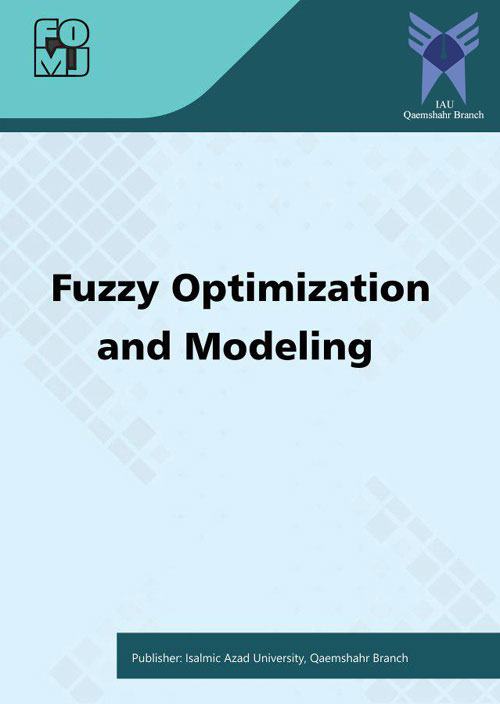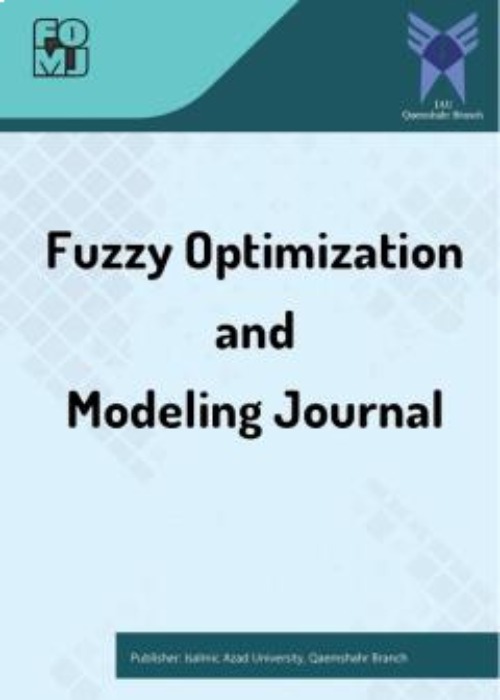فهرست مطالب

Fuzzy Optimzation and Modeling
Volume:1 Issue: 1, Spring 2020
- تاریخ انتشار: 1399/03/14
- تعداد عناوین: 5
-
Pages 1-10This paper deals with a class of bi-level linear programming problem (BLPP) with fuzzy data. Fuzzy data are mainly considered to design the real-life BLPP. So we assume that the coefficients and the variables of BLPP are trapezoidal fuzzy numbers and the corresponding BLPP is treated as fuzzy BLPP (FBLPP). Traditional approaches such as vertex enumeration algorithm, Kth-best algorithm, Krush-Kuhn-Tucker (KKT) condition and Penalty function approach for solving BLPP are not only technically inefficient but also lead to a contradiction when the follower’s decision power dominates to the leader’s decision power. Also these methods are needed to solve only crisp BLPP. To overcome the difficulty, we extend Technique for Order Preference by Similarity to Ideal Solution (TOPSIS) in fuzzy environment with the help of ranking function. Fuzzy TOPSIS provides the most appropriate alternative solution based on fuzzy positive ideal solution (FPIS) and fuzzy negative ideal solution (FNIS). An example is included how to apply the discussed concepts of the paper for solving the FBLPP.Keywords: Bi-level linear programming, Fuzzy programming, TOPSIS, Compromise solution
-
Pages 11-31
In this paper, a hybrid algorithm using fuzzy clustering techniques is proposed for developing a robust fault diagnosis platform in industrial systems. The proposed algorithm is applied in a fault diagnosis scheme with online detection of novel faults and automatic learning. The hybrid algorithm identifies the outliers based on data density. Later, the outliers are removed, and the clustering process is performed. To extract the important features and improve the clustering, the maximum-entropy-regularized weighted fuzzy c-means is used. The use of a kernel function allows achieving a greater separability among the classes by reducing the classification errors. Finally, a step is used to optimize the parameters m (regulation factor of the fuzziness of the resulting partition) and (bandwidth, and indicator of the degree of smoothness of the Gaussian kernel function). The proposed hybrid algorithm was validated using the Tennessee Eastman (TE) process benchmark. The results obtained indicate the feasibility of the proposal.
Keywords: Automatic learning, Online detection, Fuzzy clustering tools, Optimal parameters -
Pages 32-41
As it is well known, in spite of having small dimensions, there are daily manysituations that require the solution of a decision-making problem: eating, streetscrossing, assessments, shopping and so on. Generally, the way of working onthese types of problems depends on how the information used to evaluate eachalternative is provided and represented, as for instance is the case with: crisp values, fuzzy values, Pythagorean values, etc. In this way, different very wellknownmethods have been developed and modified to help to solve this kind ofproblems. Among them, the following may be remarked: AHP, PROMETHEE,ELECTRE, VIKOR, TOPSIS. But there are many other. This paper shows howto apply the so-called Reference Ideal Method (RIM), previously developed bythe authors, when Pythagorean Fuzzy numbers are used to evaluate eachalternative. The paper shows how to solve a decision-making problem throughthe proposed method using such kind of fuzzy numbers and, in order to showhow to practically apply the RIM method, an illustrative example is provided.
Keywords: Reference Ideal Method (RIM), TOPSIS, Pythagorean Fuzzy Set, MCDM -
Pages 42-51
Proper decision making in drilling bit selection issue may contribute to drilling efficiency and considerable cost reduction. Since the bit selection is a Multiple Criteria Decision-Making (MCDM) problem, MCDM techniques are the most powerful approaches to be applied in such cases. In this study, among MCDM approaches and with respect to great accuracy and validity of results, fuzzy TOPSIS method is utilized for optimum bit selection for drilling operations in Sarvak and Asmari formations in an Iranian oil field. With this regard, three types of bits (i.e. 517, 527 and 537) candidate in Asmari & Sarvak formations are analysed using fuzzy TOPSIS method to rank and prioritize the alternatives, leading to choose the best option. Considering bits operating in Asmari formation, similarity factors for bit types of 517, 527 and 537 bits found to be 0.479, 0.438 and 0.382, respectively indicating bit type 517 can be considered a proper option compared to other ones. Similarly, achieved results from application of fuzzy TOPSIS approach in Sarvak formation shows 0.5405, 0.5019 and 0.5622 values for 517, 527 and 537 bit types respectively, demonstrating the bit type 537 is the most appropriate alternative in Sarvak formation.
Keywords: Bit Selection, Fuzzy TOPSIS, Asmari Formation, Sarvak Formation -
Pages 52-60
This paper considers the rank of set efficient units in Data envelopment analysis (DEA). DEA measures the efficiency of decision making units (DMUs) within the range of less than or equal to one. The corresponding efficiencies are referred to as relative efficiencies, which describe the best performances of DMUs, and these efficient units determine efficiency frontier. This research proposes an extended on a current research by a technique for order preference by similarity to an ideal solution (TOPSIS) method. Therefore, in this paper, we first introduce two methods namely regular polygon area (RPA) and TOPSIS. Then using common set of weights in order to all efficient units obtained from DEA models, they are projected into two-dimensional plane. Finally, the units are ranked by RPA and TOPSIS methods. Also, with the numerical example, our method is compared with other methods. The obtained results of numerical example show that they are almost close to each of several methods.
Keywords: Data Envelopment Analysis (DEA), RPA, TOPSIS, Ranking


